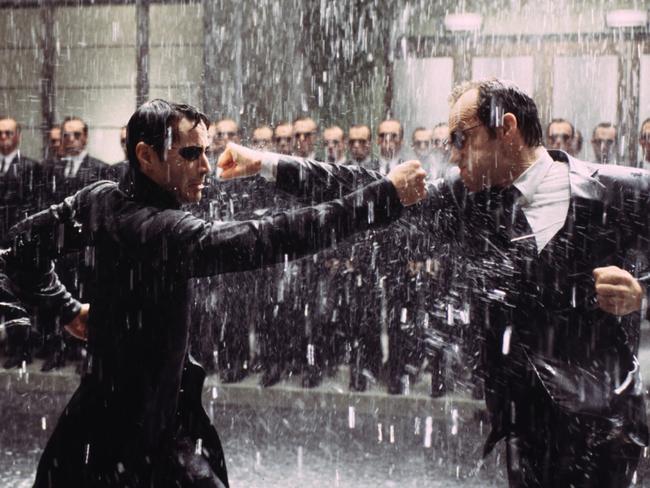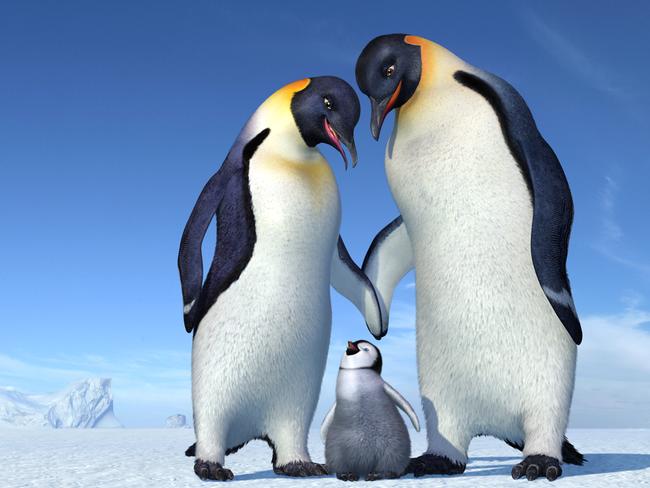Animal Logic’s co-founder Zareh Nalbandian steps down after selling Aussie studio to Netflix
For 25 years, an Australian start-up has had its fingerprints on the world’s most popular movies — including the Matrix. Now, Netflix is taking over.
Entertainment
Don't miss out on the headlines from Entertainment. Followed categories will be added to My News.
If you watch The Matrix closely, you’ll notice the sci-fi blockbuster was shot on the streets of Sydney. What you won’t see is that the Matrix itself was also made in Sydney.
That cascading green code, representing the simulated reality depicted in the 1999 movie, was developed for the Wachowski siblings by Australian visual effects studio Animal Logic.
Meeting the creative vision of the film’s directors was no easy task. The Wachowskis were only satisfied when production designer Simon Whiteley found inspiration in one of his wife’s Japanese cookbooks. He sketched out the characters he liked, and then software developer Justin Marshall created the rainfall-like effect. The Matrix was born.
“It was on everyone’s screen saver,” remembers Zareh Nalbandian, Animal Logic’s co-founder and chief executive.
“We were exporting popular culture to the world.”

So it has been for the past quarter of a century. While Australian cinemagoers may not have realised, unless they stayed behind to scrutinise the credits, Nalbandian and his team turned into a movie powerhouse with a filmography to rival our biggest Hollywood stars.
From visual effects to feature-length animations, Animal Logic’s fingerprints are on everything from Moulin Rouge and The Great Gatsby to Happy Feet, The Lego Movie and a host of Marvel hits.
The studio’s next act, however, will come without Nalbandian at the helm. The 67-year-old is stepping down this month as Animal Logic’s chief executive, after the scrappy start-up from Sydney was acquired by Netflix last year to be the streaming giant’s animation arm.
“I don’t know if you can believe these things when people tell you, because it sounds so good for your ego, but they said there was only ever one studio they really saw as being a good fit and that was Animal Logic,” Nalbandian says.
“The fact that people like (chairman) Reed Hastings and (chief executive) Ted Sarandos saw Animal Logic as their Pixar … was so inspiring for me, to think that I could hand the company over to a new owner that was so dedicated to its future.”

The Netflix deal, worth a reported $700m, is the remarkable culmination of a simple strategy drawn up by Nalbandian and his co-founder Chris Godfrey in 1991.
“Our whole business plan was to do great work, and good things will happen,” Nalbandian says.
“That was it … We’ve lived by that ever since.”
FROM “IMMIGRANT KID” TO OSCAR WINNER
Animal Logic’s success, in Nalbandian’s telling, is a story of accidents and opportunities.
It starts with his Armenian parents, who fled to Cairo during the genocide and then moved a six-year-old Nalbandian – along with his brother and sister – to Sydney.
“They came to Australia to start their lives over for a third time, as immigrants do sometimes, and lucky for me they did because it certainly created a lot more opportunity,” he says.
Life in Australia was not easy “as an immigrant kid in the 60s and 70s”, Nalbandian recalls, but he was determined to succeed.
Offered a traineeship at Colorfilm, Australia’s first film post-production company, Nalbandian was the only person to complete the two-year program. He liked photography as a child but it was here that he “fell in love with the whole idea of visual effects”.
After becoming the general manager, a role Nalbandian hated because he “really missed being hands on”, he left to team up with Godfrey – a visual effects supervisor – and create a graphics software company called Discreet Logic.

They soon sold it off and established Animal Logic, a visual effects firm with a team of 12 that initially worked on advertising campaigns, from Louie the Fly’s adventures for pest control brand Mortein to Michael Jordan leaping over a Chicago bridge in a spot for Nike.
Nalbandian says it was an “amazing foundation” for the studio, both to hone their technical skills and to build relationships that fortuitously opened the door to Hollywood.
Animal Logic’s first US client was Gore Verbinski, the Pirates of the Caribbean director who worked with the studio on a Skittles ad and then hired them for 1997 comedy Mouse Hunt.
Zack Snyder was also an advertising client before he teamed up with them for the historical action epic 300. He later directed Legends of the Guardians: The Owls of Ga’Hoole, an animated feature made by Animal Logic which was the first film Nalbandian produced.
“It was an organic progression,” Nalbandian says.
“Film was the next frontier … We could see that we couldn’t stand still. The whole business of visual effects and animation has been a revolution over the last 30 years.”
“We had to keep moving and we had to keep innovating.”
Godfrey’s connection to director Baz Luhrmann put them on the team for Moulin Rouge, and then Australia, The Great Gatsby and his extravagant Chanel commercial. What also worked to the studio’s advantage, Nalbandian recalls, is that “we didn’t know what we didn’t know”.

“We were a natural fit because his aspirations were really out there,” Nalbandian says.
“We were prepared to try anything. You want to create Paris digitally? Sure, we can do that.”
But it was the Oscar-winning Happy Feet – the first digitally animated feature film produced in Australia – that really put Animal Logic on the map. Nalbandian says it turned them “from shotmakers to filmmakers”, developing original stories instead of only telling someone else’s, backed by a supercomputing capability that was at the time bigger than the Pentagon’s.
“Afterwards I felt really kind of not great about that stat,” laughs Nalbandian, “given the environmental impact when we were making a movie about the environment.”
Nevertheless, it underscored the studio’s focus on finding what he calls “the perfect intersection between creativity, technology and commerce”.

“Our creatives drive the technologists, and the technologists sometimes offer the creatives pathways they couldn’t dream of,” Nalbandian says.
For instance, when Phil Lord and Christopher Miller dreamed up The Lego Movie, Nalbandian knew it would be impossible with existing graphics technology.
“They wanted a Michael Bay film that looked like stop-motion, with big action sequences where Lego models would fall apart and reform,” he says. So Animal Logic developed its own technology to make and render 3,863,484 Lego bricks – and another hit movie.
NETFLIX TAKES OVER SCRAPPY START-UP
Over three decades, Nalbandian can’t remember having a bad year creatively. Financially, however, he acknowledges there were times “when my wife will attest that I didn’t sleep”.
“I had to retain 200 people for a year without the level of income that’s required as an independent company without deep pockets,” Nalbandian says.
“It was really touch and go, but I’m glad I did, because you can’t just pay lip service to the idea that a company is about its people. If I hadn’t retained those people, we would have lost so much capability that we may have never picked up and got going again.”
Strangely enough, the pandemic was a growth period for the studio, coming soon after Nalbandian’s decision to walk away from visual effects work and focus solely on animation.
Animal Logic had contributed to some of Marvel’s biggest films – including Captain Marvel, Guardians of the Galaxy Vol. 2 and Iron Man 3 – but Nalbandian says his “mixed feelings” about their dominance of the movie industry spurred him to change direction.

“You just became a cog in the works,” he says.
“It was always very price competitive, it was always very time pressured, and you were kind of two layers removed from the true creativity of filmmaking.”
“I’m not putting down the work that’s being done because I’m in awe every time I go to the movies … I just feel like it starts to become very commoditised.”
The studio grew into an 800-strong team across Sydney and Vancouver during Covid, positioning itself perfectly to meet Netflix’s desire to produce its own animated content.
Nalbandian understood their strategy because the streaming giant understood Animal Logic’s culture, its “innovative DNA” and its “occasionally slightly scrappy attitude”.

“We’re not a big corporate,” he says.
“You can’t become a factory. It’s a creative business – it’s all about the people.”
Animal Logic’s people, of course, do not receive the popular acclaim as Australia’s best actors and directors. But for Nalbandian, that is a point of pride, as well as a persuasive piece of evidence when he lobbies to improve training programs and retain skills onshore.
“When you play a reel for politicians that shows how The Great Gatsby was made in Sydney, and you show the before and after, their jaws drop,” he says.
“But you don’t want audiences thinking about that stuff. You just want them to be into the story, and if you can do that transparently, you’ve succeeded.”
Originally published as Animal Logic’s co-founder Zareh Nalbandian steps down after selling Aussie studio to Netflix





